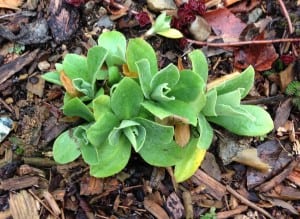Predictions and inspiration for 2016
By Pamela Doan
Learn — Take a class at Stonecrop Gardens or the Cornell Cooperative Extension of Putnam County (“Planning a Vegetable Garden” is a free class coming up in Carmel on Wednesday, Jan. 13). If you’ve got more time and access, trek down to the New York Botanical Garden in the Bronx to explore a new subject or pick up a new skill. Read about permaculture, agroforestry, xeriscaping or edible landscaping.
Experiment — Try a new variety of vegetable, grow one new vegetable you’ve never tried before, create a water garden, transplant and divide plants, try a new technique or design approach.
Go big — Replace your lawn with native grasses or a meadow. Plant a rain garden to capture runoff in your own yard. Double or triple the size of your vegetable garden. Turn your roof into a garden.

You might love the pawpaw — Nothing could be more impressive than treating friends to their first pawpaw from the tree in your yard. This native fruit tree has been described to me as part mango, part banana. Pollinators love it and it’s a host for two varieties of larva for butterflies, the zebra swallowtail and pawpaw sphinx caterpillars. Birds and other wildlife will eat the fruit, as well, if it turns out not to be friendly to your palate. Pretty purple flowers in spring and bright yellow foliage in fall make it a beautiful addition.
Stop buying bird seed when winter ends — Instead, fill the yard with trees, shrubs and plants that will sustain birds in spring, summer and fall. This could be from plants with berries or seeds and plants that attract insects the birds need to survive. YardMap.org is a website with a mapping tool and all the resources you need.
Pretty and sterile are out — The visual impact of our efforts in the yard is one of the biggest rewards but go for plants that are both beautiful and valuable for other creatures like bees and butterflies. Sterile landscapes are not much better than paved parking lots in terms of their ecological value. Big lawns and exotic species don’t contribute to the vitality of any creatures.
Embrace chaos — What I love about gardening is that no matter what I do, I can’t control it and I’ll make myself crazy if I try. Go with the flow and try out native plants that are good at re-seeding like Joe Pye weed, thistle or milkweed. A few of these can thrive and spread. Birds and butterflies will love it, too.
Got shade? Use it — Sunlight is overrated in a warming world. Take advantage of tall trees and learn about what grows in their shadows. Another advantage is that the tallest trees sequester the most carbon.
Don’t waste water — It’s very clear that as weather patterns change due to global warming, rainfall isn’t always going to be where you want it, when you want it. This year we experienced a drought in our area and anyone with a garden was very conscious of the work involved in keeping plants alive. Plan for capturing rainfall in barrels and use mulch to keep the moisture in the ground.
Get rid of invasive species in your yard — The Department of Environmental Conservation took a huge step this year to control the spread of invasive species when it banned and regulated certain trees, plants and shrubs. Many such as Japanese barberry and golden bamboo had been popular landscape plants. While the regulations prevent the sale or import of these species, many people already have them in their yards and they can spread when birds carry the seeds. Help stop these aggressive invaders from taking over more natural spaces by finding alternatives for your landscape.
Do less work — Mulch for weed control and water conservation. Plant a cover crop to improve the soil. Mow less by decreasing your lawn size and letting it grow higher. Don’t till the soil but add organic matter on top instead. Start with healthy soil and plant for the conditions you’re working in.
More joy! — Gardening can be one of the most pleasurable, relaxing and satisfying experiences. Or it can be one backbreaking chore after another. If your relationship is the latter instead of the former, change your approach, your design or your plants — whatever it takes to find more enjoyment in your efforts.
